 We’ve come back to Athens specifically to see the new Acropolis Museum, a project that has taken over 10 years to design and build. It was originally scheduled to open for the 2003 Olympics, but then, it’s Greece. Things move slower here, mostly because as soon as someone sticks a shovel under the ancient ground, they find an ancient treasure. That alone could stop the project for a year or two; or more.
We’ve come back to Athens specifically to see the new Acropolis Museum, a project that has taken over 10 years to design and build. It was originally scheduled to open for the 2003 Olympics, but then, it’s Greece. Things move slower here, mostly because as soon as someone sticks a shovel under the ancient ground, they find an ancient treasure. That alone could stop the project for a year or two; or more.
When we came here in 2000, we visited the old Acropolis Museum behind the Parthenon. It was a small dark building filled with small treasures in a very confusing layout. To be honest, the only thing I really remember from the old museum were the 5 Caryatid statues from the Erechtheum, imprisoned behind a layer of dull, dirty glass. The ones holding up the porch of the Erechtheum these days are copies. Four of the originals are in good shape and one was just a torso. There were originally 6 Caryatids. The missing one was taken by Lord Elgin in 1806 as a decoration for his living room. It now sits in the British Museum. Lord Elgin is not well loved in Greece.
When we were here in May of 2007, mostly to see this new Acropolis Museum, there were signs all around the Acropolis Hill announcing the new museum would open in September 2007. Oh well, we had a great time anyway.
Last year, in 2008, rumors of the museum opening hit the news again. This time the grand opening was announced for June 2009. They even had a website showing the building (designed and built by a French Swiss team). And sure enough, in June 2009 the museum finally opened. We pre-purchased our tickets on the internet for €1 each, a special introductory price for the first few months.
The man at the ticket window told us it should take 90 minutes to see the entire collection but you can stay as long as you want. We did. We were there for 3 hours and only left because we had reached Acropolis overload.
The building is shiny and new, unlike anything else around it. The exterior is covered with shaded glass that is so mirror-like, on a sunny day, it reflects an image of the Parthenon over the entrance. At night, the ancient statues glow through the glass as if they are lit behind a theatre scrim.
The walkway towards the entrance is made of thick polyglass panels and reveal the ancient city that was built up around the Acropolis hill, the same city ruins that probably held up the museum’s completion for 6 years. It’s really amazing to walk over so much history.
The Parthenon, Erechtheum, theatre of Dionysius and a few other buildings were all built around the age of Pericles and the Golden Age of Greece, between 500BC and 400BC. The community at the bottom of the hill is much older.
The entrance floor is built on an incline, giving you the sensation of walking up to the top of the Acropolis. On the way up you see examples of the pottery, votive offerings and family life. There is a “thesaurus” (treasure box) were friends would donate money towards the marriage of two people to help them start their new life.
There was an Asclepieion in the village under the gaze of the Acropolis Hill. This was the hospital where the locals worshipped Asclepios, the god of medicine and good health and his daughter Hygeia (possibly the goddess of good hygiene). Votives of the gods were brought here as worship and the engraved requests of the sick were laid at the temple for specific aid. If you had a problem with your arm, you would leave a plaque with an etching of an arm, a hand problem called for a hand plaque. There were plaques of noses, arms, feet, heads.. Even though it seems like it was a “make a wish” hospital, the Asclepieion did actually deliver medical treatments.
We came across an Asklepeion in Epidavros (see the entry of Peloponnese 2007) where the sick came for supernatural healing. After going through a purification procedure, the patient would offer an animal to be sacrificed and then be taken to a sleeping room (in a purified building). During the night, while he slept, either Asklepios, his snake or his dog would visit the patient in a dream. When the patient awoke he would tell the priest his dream and the priest would interpret it and give him the proper therapy.
Hippocrates, the Father of Medicine, and the founder of the first school of medicine, was born in Kos (see the entry for Kos 2007) and set up his school and hospital at the Asklepeion of Kos. At it’s height, the Asklepeion was administering medical aid to thousands of people from all parts of the Mediterranean.
The second floor of the museum has examples of the various types of marble used; Naxos, Parian, Porous and Pentelic. They all came from different parts of Greece. They all had different properties and were used for different purposes; some for statues, some for columns, some for a frieze or metop and so on. There are also some pretty amazing sandstone carvings and ceramic pieces dating back to the 7th century BC, before the Archaic period (the Persian Wars).
One section of the 2nd floor is reserved for the Caryatids from the Erechtheum. They are set into the position they would have known when they were supporting the enclosed porch of the ancient temple. The scale is exactly the same at the where they once resided. This is the first time we have ever been able to see the them close up and from all sides. They are amazing. They’ve been cleaned and preened and look better than they’ve looked in a long time. From the front they all look very similar. From the back, they are all different; different hair styles mostly.
There were once 6 Caryatid statues supporting the Erechtheum. Four of the five Caryatids are very well preserved, the fifth has been severely damaged over time. There is a very conspicuous empty space for the 6th and last sister, who has been imprisoned in the British Museum, separated from her other sisters for over 300 years. Yes, the Greeks are very eager to make the statement that the collection is not complete. There are many references to Lord Elgin and none of them are very good ones.
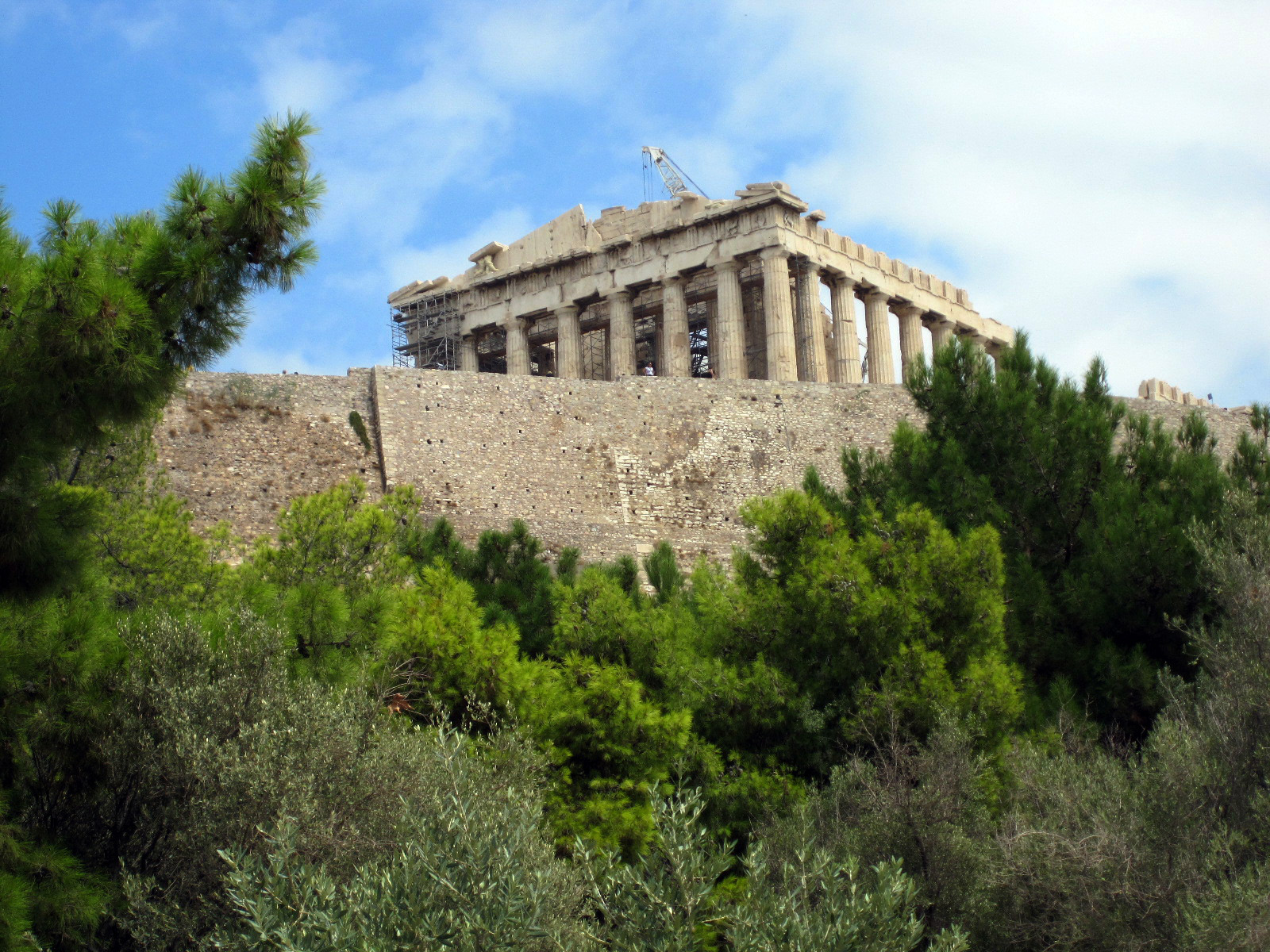 The top floor is dedicated to the Parthenon. This is a room a little bigger than the Parthenon Temple itself. In the center of the room is a exact scale of the pediments, the frieze and the metops, the three graphic elements that tell the story of the Temple of Athena. You can see the actual Parthenon up on the Acropolis Hill through the glass windows of the museum. You can only imagine how beautiful it must have looked when it was completed and fully painted in vivid colors in 490BC. Where’s Mr Peabody when I need him.
The top floor is dedicated to the Parthenon. This is a room a little bigger than the Parthenon Temple itself. In the center of the room is a exact scale of the pediments, the frieze and the metops, the three graphic elements that tell the story of the Temple of Athena. You can see the actual Parthenon up on the Acropolis Hill through the glass windows of the museum. You can only imagine how beautiful it must have looked when it was completed and fully painted in vivid colors in 490BC. Where’s Mr Peabody when I need him.
The Parthenon Temple to Athena is supported by 50 columns that contain 16,500 pieces of marble. It a very clever design; the columns are slightly thinner at the top and they are slightly curved to give the roof more support. You can read more about the design and architecture of the Parthenon in our 2000 Athens entry.
The metop panels (which once sat directly above the columns) are a series of copies that describe man’s struggles of life, love and society. 15 of the original 92 panels were taken by Lord Elgin and now live in the British Museum, something the Acropolis Museum will tell you more than few times. There are four scenes (for each side of the building). The metopes show the battle of the gods against the giants, the battle of the Athenians against the Amazons, the Sack of Troy and the battle of the Lapiths and the Centaurs. When athe King of Lapith invited the entire kindgom to attend his wedding to Deidameia of Eurytionas, he made the mistake of also inviting the Centaurs (note: never invite Centaurs to your party, it’ll always turn out bad). The Centaurs got drunk and tried to (let’s just say) have their way with the women, including the bride. A fight broke out. The casualties were many on both sides.
The Frieze panels show the procession of armies and people coming to see the moment when Athena will receive the gift of the temple. There are 378 human/god figures, 220 animals, lots of food and many wagons carved into the marble. Soldiers are racing to the temple on one wall, but just as they turn a corner, someone slows them down. “Hey, there are other people around the corner in the same procession. Slow down or you’ll crash into them.” There are a few amusing moments in the festivity of the race to get the ceremony. The Greeks had a very good sense of humor.
In 1674 an artist named J. Carrey painted a very complete study of the Parthenon. Thanks to his artwork, the Archeological artists have been able to reassemble a lot of what blew up in 1687 when the munitions depot blew. The Carrey details are the only images we still have of the pre 1687 frieze panels.
The Pediment is mostly gone. It’s been reassembled with original pieces and filler. One side tells of the birth of Athena (she popped out of Zeus’ head). The other side tells the story of a contest between Athena and Poseidon. These are the two main gods of Athens.
There is a very interesting film along with the exhibit that tells the story of the Parthenon. There was a large fire in 267AD. In 1205, it became a Christian church. The film shows a digital recreation of the Christians desecrating elements of the frieze, pediment and metopes, tearing at the them with hammers and chisels and tossing them off the Acropolis hill.
I read a few months ago how the elders of the Greek Church was upset about the film’s digital recreation. They didn’t deny it was true, and they didn’t mind the reference of the desecration in the dialogue, but they were appalled by the digital Christians on top of the Parthenon hacking away at the temple. The Archeology commission was unmoved by the Church’s plea. The digital desecration remains.
The Elgin Marbles (also known as the Parthenon Marbles) include 17 figures from the Pediments, 15 of the original 92 panels of the metopes (including the battle between the Lapiths and the Centaurs) and 247′ of the original 524′ of the Frieze. Elgin also took the missing Caryatid and a few other statues. It was quite a haul.
There are 2 stories of how Thomas Bruce, the 7th Earl of Elgin obtained the loot from the Acropolis Hill. One story says in 1806 he got permission from the Ottoman empire to remove as much as he could. The second story (and the one believed by most Greeks) is that he received permission to make sketches and rubbings of the reliefs. Lord Elgin told the Ottomans that he could get a better rubbing if he was able to move some of the debris out of the way. The Ottomans agreed. Unfortunately for the Greeks, Lord Elgin’s interpretation of getting a better view was moving them to London. He kept them for a while at his home and then sold them to the British Museum.
The Greeks have had a Poseidon Trident up their national butt for close to 100 years trying to bring the Elgin Marbles home, but the British Museum has been pretty headstrong and the answer has continually been “finders keepers, losers weepers”. For a while the British Museum said that the marbles were better off in London because there was no place in Athens to protect them. I agree that the old Acropolis museum might not have been a good spot to retain their preservation. But the new museum is modern and well designed for the preservation of the antiquities. Everything from the Pantheon to the Caryatids to the small pottery is so engaging and well displayed, even many British writers are saying that the Elgin marbles would undoubtedly look much better in here than in the British Museum.
Returning museum pieces to their native country would open a Pandora’s box of petitions all over the world. Would the Louvre give back things Napoleon stole from Egypt? Would the Pushkin Museum in Moscow give the Troy jewels back to Turkey? Would the Pergamum Museum in Berlin move to Pergamum, Turkey? Would the Reina Sophia Museum in Madrid give Picasso’s Guernica back to the Basque? It’s a risky precedent. I think the Elgin Marbles will stay in London. Gretchen thinks the answer is for the British Museum to put a sign next to the Elgin Marbles that reads “On permanent loan from the Acropolis Museum”.
I have one more story about the Acropolis museum. There is a early 20th century Greek Deco houses that sits right next to the Museum. In the original plan, the house was to be torn down. The Museum needed the space. The owners were appalled. Not only was the house one of the best surviving examples of the early 20th century architecture in Athens, there were people were living in it. It’s been occupied since it was built. The fight went on for years. The house is still standing. It was spared. There was a note on the wall of the Deco house (in English) thanking everyone for their support.
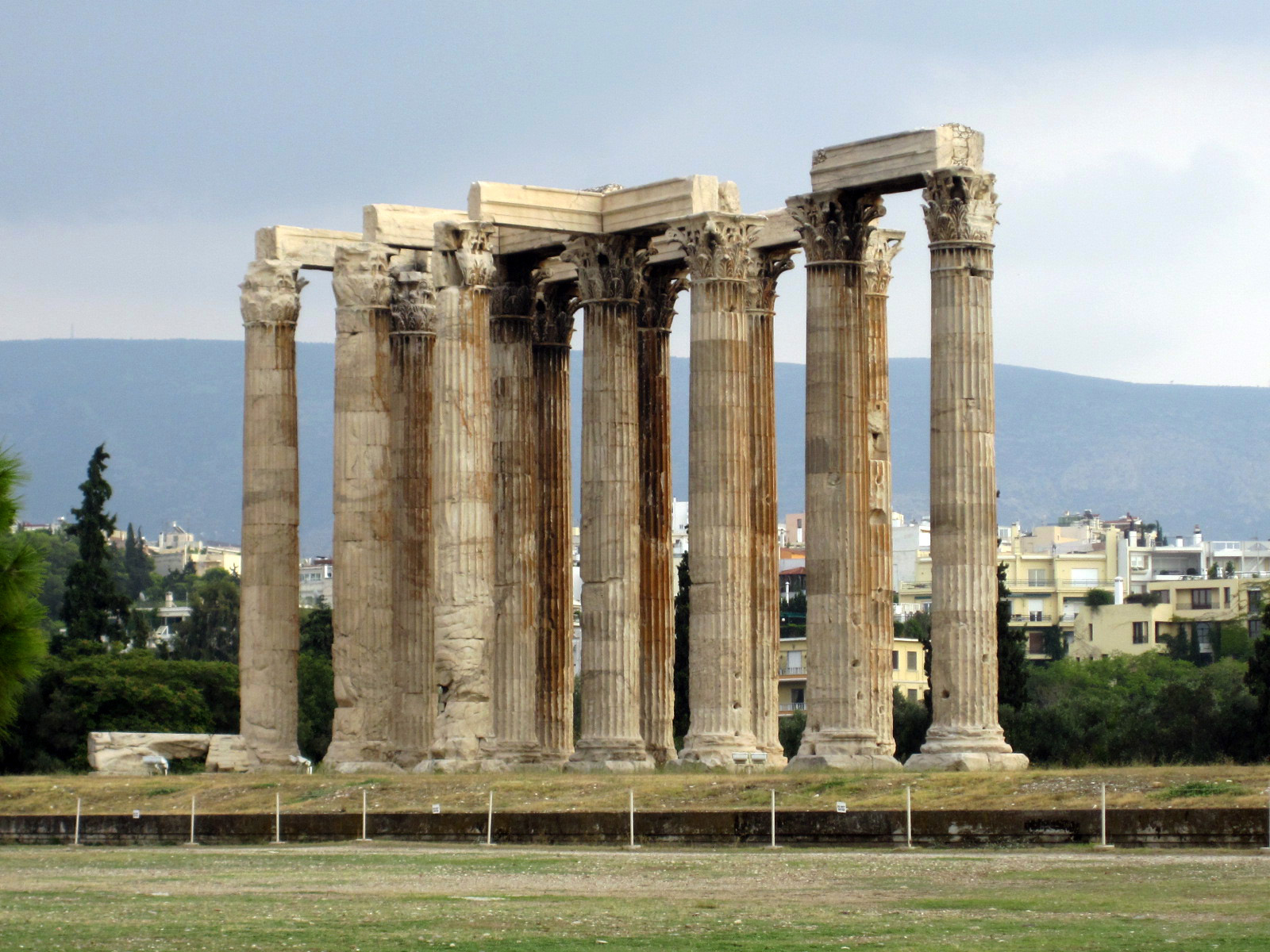 We are staying across the street from the Temple of Zeus with it’s 50’ tall columns. About 100 meter up the street is the remains of Hadrian’s gate that once separated the old Greek city from the new Roman city. These days the Arch separates the busy streets of the city with the small streets of the Plaka, the Mecca of tourist crap and overpriced food.
We are staying across the street from the Temple of Zeus with it’s 50’ tall columns. About 100 meter up the street is the remains of Hadrian’s gate that once separated the old Greek city from the new Roman city. These days the Arch separates the busy streets of the city with the small streets of the Plaka, the Mecca of tourist crap and overpriced food.
We moan about the chaos of the Plaka, but just like other tourists, we are drawn to it’s call. Plaka waiters wave their arms at you like toreadors trying to pull you into the spell of the restaurant’s fine dining. Shop merchants shout at you to come in and look around. “We give you the best price”. Everyone has the best price and if not, you can haggle and argue the price. It’s expected in this culture. Usually you can get the item for at least 30% less.
Our hotel is full of foreign tourists, most of them Americans. One morning at breakfast an American woman said “Kalmara” to one of the breakfast waitstaff. The waiter replied, “Kalmara is the fish, Kali Mera is good morning.”
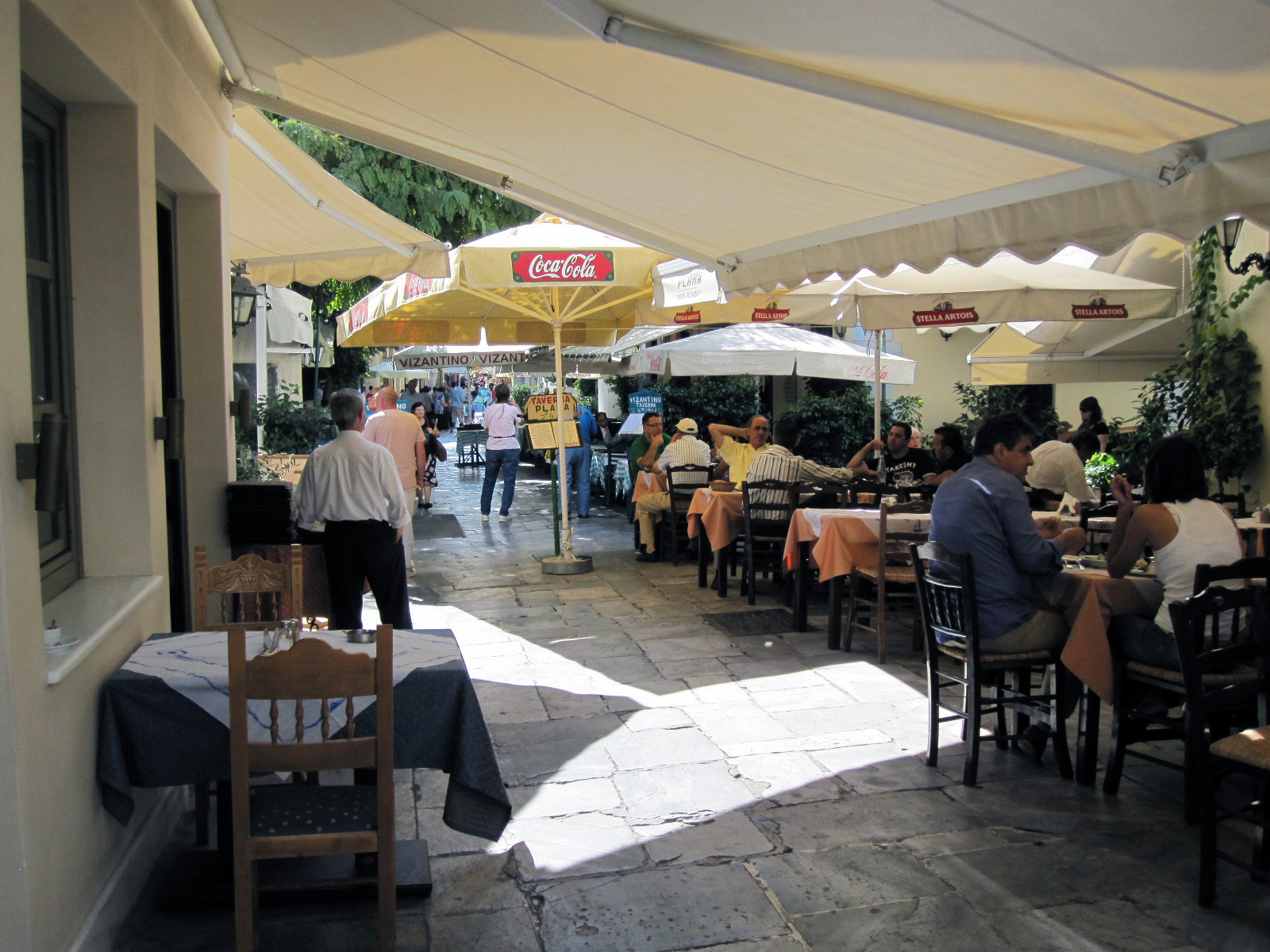 The streets of the Plaka are designated as pedestrian use only, but pedestrians in Greece include motorbikes, cars and small delivery trucks. For the 2003 Olympic games, these small streets were resurfaced with beautiful marble tiles but the traffic has exhausted them in just 6 years. Many of the tiles are cracked. Some of them have disappeared completely and have been replaced with a strange mixture of cement that resembles hardened oatmeal. It probably won’t be too long before they’ll just get paved over and return to the relaxed pre 2003 appearance.
The streets of the Plaka are designated as pedestrian use only, but pedestrians in Greece include motorbikes, cars and small delivery trucks. For the 2003 Olympic games, these small streets were resurfaced with beautiful marble tiles but the traffic has exhausted them in just 6 years. Many of the tiles are cracked. Some of them have disappeared completely and have been replaced with a strange mixture of cement that resembles hardened oatmeal. It probably won’t be too long before they’ll just get paved over and return to the relaxed pre 2003 appearance.
 HYDRA
HYDRA
It’s a 15 minute metro ride on the green line to Piraeus (the port city) and a 90 minute ride on the hydrofoil to Hydra, one of the prettiest of the Saronic archipelago.
In the 70’s and 80’s it was home to famous celebrities. Leonard Cohen and Mick Jagger owned houses here. And where there are celebrities, there are celebrity seekers. An industry of jewelry shops and expensive restaurants built up around the beautiful horseshoe cove. The celebrities are gone (or at least well hidden) these days but the jewelry, clothing and cafes are still eager to swap a Hydra memory for your euros.
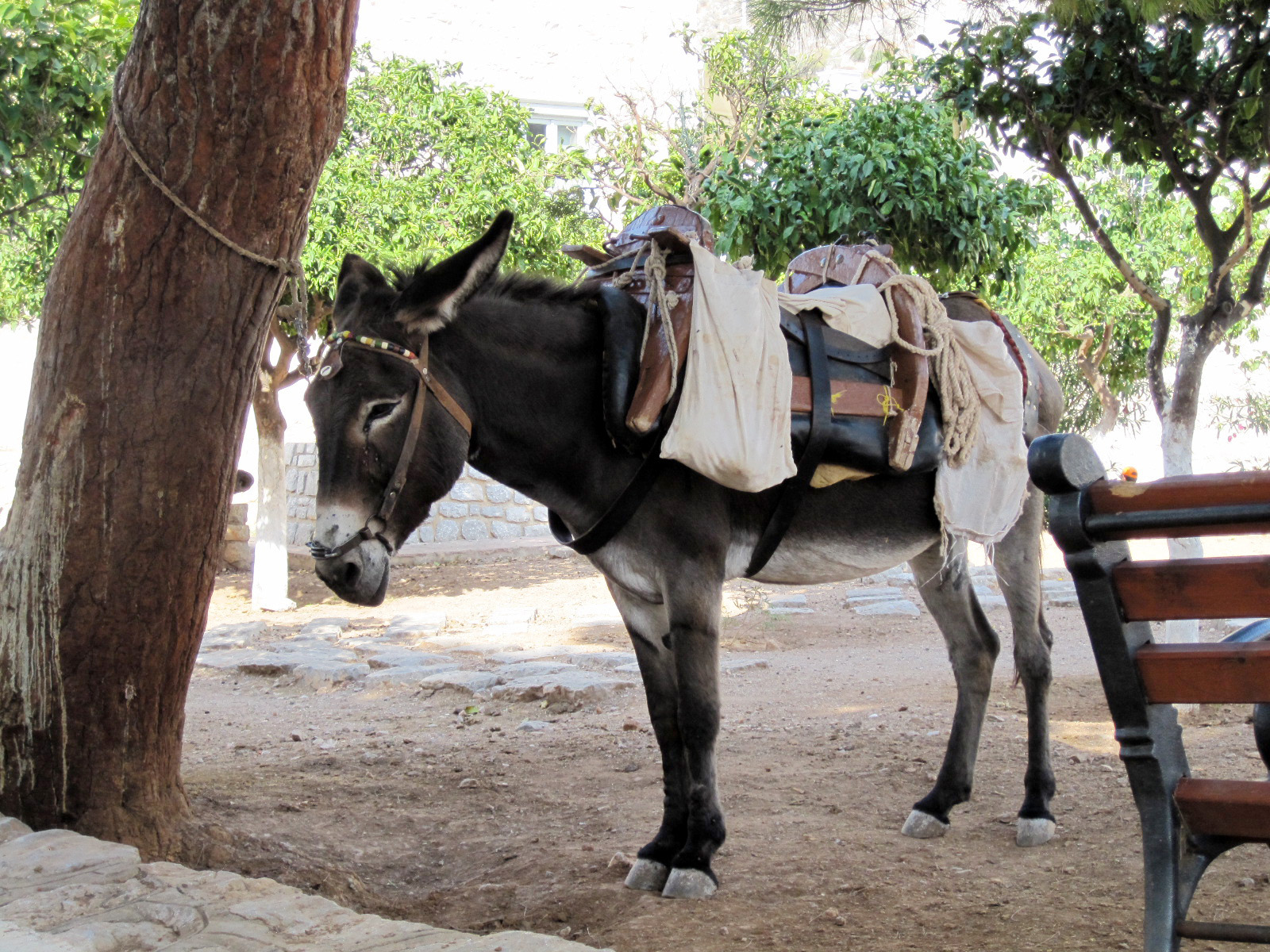 There are no cars or motorcycles allowed on the island. The only way to get around is by mule, the same way the locals have been getting around for the past 2000 years or so. The mule drivers are there to meet you as you get off the boat. In most cases it’s like taking a Pony ride when you were 6 yrs old, but we saw a couple of experienced riders whip the little critters into a pretty good gallop (if gallop can be used when talking about a mule).
There are no cars or motorcycles allowed on the island. The only way to get around is by mule, the same way the locals have been getting around for the past 2000 years or so. The mule drivers are there to meet you as you get off the boat. In most cases it’s like taking a Pony ride when you were 6 yrs old, but we saw a couple of experienced riders whip the little critters into a pretty good gallop (if gallop can be used when talking about a mule).
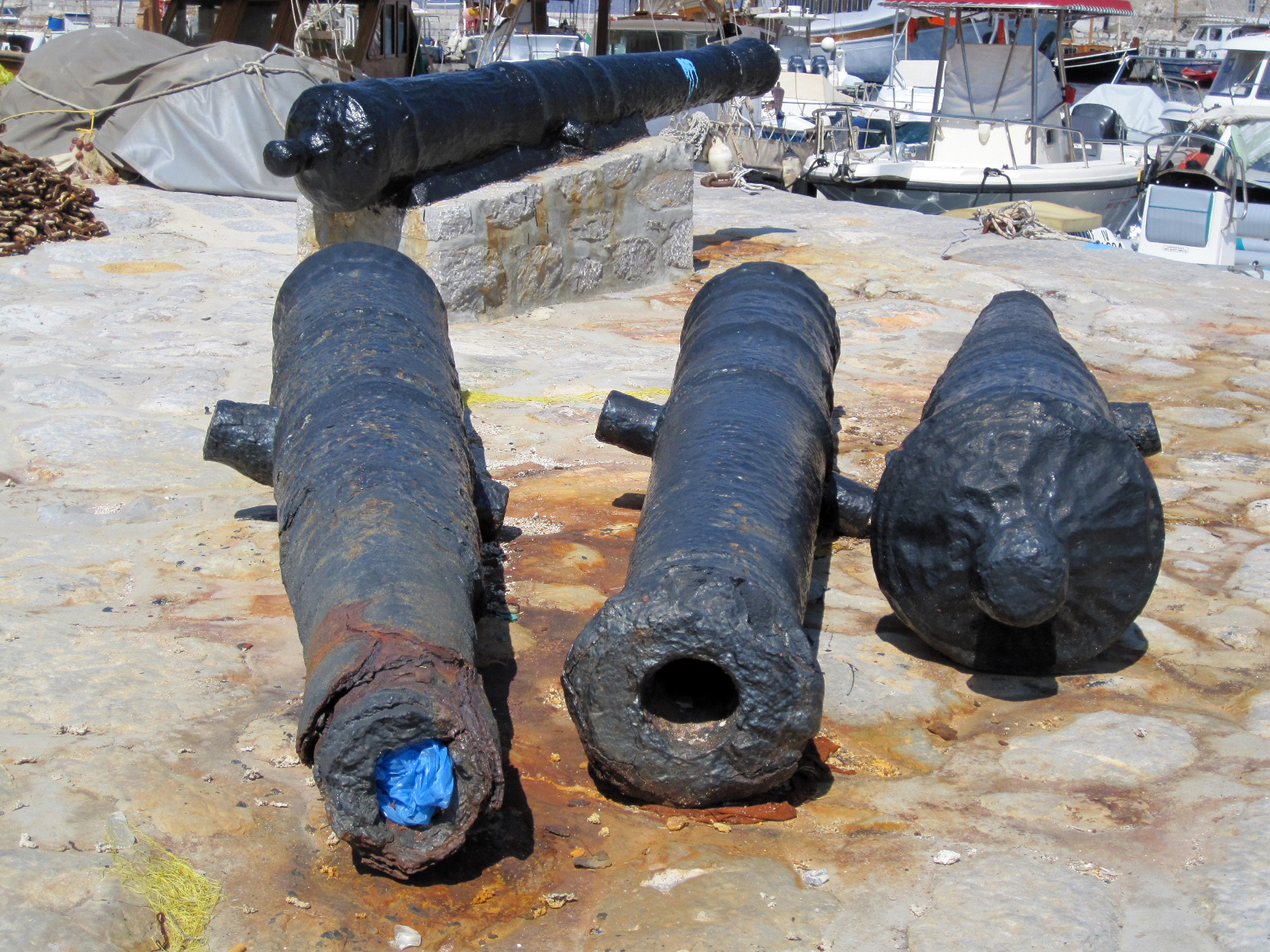 Hydra is one of the precious Greek islands that you read about; quaint small streets that climb up hills to nowhere, fabulous views across the blue Aegean Sea, an old fortress and wonderful fresh seafood.
Hydra is one of the precious Greek islands that you read about; quaint small streets that climb up hills to nowhere, fabulous views across the blue Aegean Sea, an old fortress and wonderful fresh seafood.
Speaking of the fortress, there is a heap of cannons laying around the island like scrap metal. Many Greek islands served as ports of defense since the 7th century BC, maybe even earlier In the 13th century some of the were fortified by the Crusades. In the 16th, 17th and 18th centuries a lot of them were fortified by both the Venetians and the Ottoman Turks. With the invention of the airplane, the fortress became a moot point. City walls replaced fortified walls, fortress castles became tourist museums. The hundreds of leftover cannons just became municipal art. We’ve even seen them vertically buried and used as traffic bollards. On Hydra they just lay around looking like salvaged junk. It probably cost more to move one than to just leave it there. We’d love to bring one home with us back to San Francisco.
We had a great walk and a delicious lunch. It was a great little day trip from Athens. On the hydrofoil back to Piraeus we saw a really old submarine floating in the Aegean. We couldn’t decide if it was emerging or submerging, but it looked like it had been submerged for the last 80 years. We’re always hoping to see a giant Greek sea monster or maybe even Poseidon himself every time we come near these waters. I guess the submarine will have to do.
You must be logged in to post a comment.